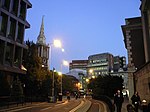30 St Mary Axe

30 St Mary Axe (previously known as the Swiss Re Building and informally known as the Gherkin) is a commercial skyscraper in London's primary financial district, the City of London. It was completed in December 2003 and opened in April 2004. With 41 floors, it is 180 metres (591 ft) tall and stands on the sites of the former Baltic Exchange and Chamber of Shipping, which were extensively damaged in 1992 in the Baltic Exchange bombing by a device placed by the Provisional IRA in St Mary Axe, a narrow street leading north from Leadenhall Street.After plans to build the 92-storey Millennium Tower were dropped, 30 St Mary Axe was designed by Norman Foster and the Arup Group. It was erected by Skanska; construction started in 2001.The building has become a recognisable landmark of London, and it is one of the city's most widely recognised examples of contemporary architecture. It won the 2003 Emporis Skyscraper Award.
Excerpt from the Wikipedia article 30 St Mary Axe (License: CC BY-SA 3.0, Authors, Images).30 St Mary Axe
Saint Mary Axe, City of London
Geographical coordinates (GPS) Address Website External links Nearby Places Show on map
Geographical coordinates (GPS)
| Latitude | Longitude |
|---|---|
| N 51.514444444444 ° | E -0.080277777777778 ° |
Address
30 St Mary Axe (Swiss Re Building)
Saint Mary Axe 30
EC3A 8EP City of London
England, United Kingdom
Open on Google Maps





